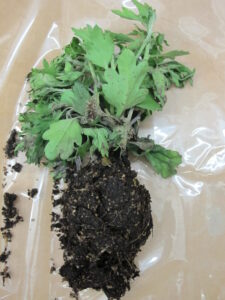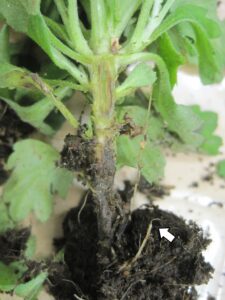Mum Growers, Beware of Pythium
go.ncsu.edu/readext?814374
en Español / em Português
El inglés es el idioma de control de esta página. En la medida en que haya algún conflicto entre la traducción al inglés y la traducción, el inglés prevalece.
Al hacer clic en el enlace de traducción se activa un servicio de traducción gratuito para convertir la página al español. Al igual que con cualquier traducción por Internet, la conversión no es sensible al contexto y puede que no traduzca el texto en su significado original. NC State Extension no garantiza la exactitud del texto traducido. Por favor, tenga en cuenta que algunas aplicaciones y/o servicios pueden no funcionar como se espera cuando se traducen.
Português
Inglês é o idioma de controle desta página. Na medida que haja algum conflito entre o texto original em Inglês e a tradução, o Inglês prevalece.
Ao clicar no link de tradução, um serviço gratuito de tradução será ativado para converter a página para o Português. Como em qualquer tradução pela internet, a conversão não é sensivel ao contexto e pode não ocorrer a tradução para o significado orginal. O serviço de Extensão da Carolina do Norte (NC State Extension) não garante a exatidão do texto traduzido. Por favor, observe que algumas funções ou serviços podem não funcionar como esperado após a tradução.
English
English is the controlling language of this page. To the extent there is any conflict between the English text and the translation, English controls.
Clicking on the translation link activates a free translation service to convert the page to Spanish. As with any Internet translation, the conversion is not context-sensitive and may not translate the text to its original meaning. NC State Extension does not guarantee the accuracy of the translated text. Please note that some applications and/or services may not function as expected when translated.
Collapse ▲July is the month when mum producers start seeing wilting plants due to Pythium root rot, with more cases turning up in August and September. If you have not been taking steps to prevent losses to this disease, there may still be time to forestall some losses.
Pythium species are fungus-like “water molds” that can infect a wide range of herbaceous plants. The usual point of attack in mums is the root system. Roots turn brown and the exterior portion can slough off leaving only the central vascular bundle (“rat tailing”). Above ground, the foliage wilts as a result of loss of root function. Leaves do not develop spots or turn yellow unless other problems are also present. From the roots, Pythium can move up into the stem and cause reddening of the woody tissue at the base, lower stem rot, or even vascular streaking that could be confused for Fusarium wilt. On occasion, Pythium will cause a full-blown stem and foliage blight in mums.
Spread of Pythium can occur through contaminated equipment, splashing of water, infected potting media, infected liners, etc.
The following steps may be helpful in preventing losses to Pythium root rot.
1) Be sure that no soil is coming in contact with plants or potting mixes.
2) Carefully inspect all liners for disease and pest problems.
3) Avoid excess irrigation and excess fertilization.
4) Verify the functioning of the the water sanitation system periodically.
5) Consider preventive fungicide applications. It’s important to keep in mind that fungicides will not cure established infections. Be sure to follow all label indications and rotate among products with different modes of action (different FRAC groups). Try any new product on a small scale first, to be sure you don’t cause damage to the crop. The efficacy of fungicides against Pythium is variable, depending on the species of Pythium and the host plant involved. The best products against Pythium root rot in North Carolina are those with the active ingredients mefenoxam (Subdue Maxx), etridiazole (Terrazole, Truban), fenamidone (greenhouse only) (FenStop), fluopicolide (Adorn), or cyazofamid (Segway O). Use the medium to high end of the range of labeled rates. Unfortunately, biocontrol products have performed poorly in testing against Pythium.
If Pythium root rot has been confirmed in your operation, discard affected plants and potting mix. If pots must be re-used, they should be scrubbed clean and then sanitized. Information about sanitizers is available in the Disease Chapter of the current North Carolina Agricultural Chemicals Manual. If you use a drip irrigation system, the stakes/emitters should also be sanitized. Check with the manufacturer for how this can be done. In the greenhouse, clean and sanitize bench surfaces between crops.
The other perennially recurring disease of chrysanthemums is Fusarium wilt. This was profiled in a news item in September 2020 on this site. It’s not unusual to see both Pythium root rot and Fusarium wilt occurring at the same facility or even on the same plant.




